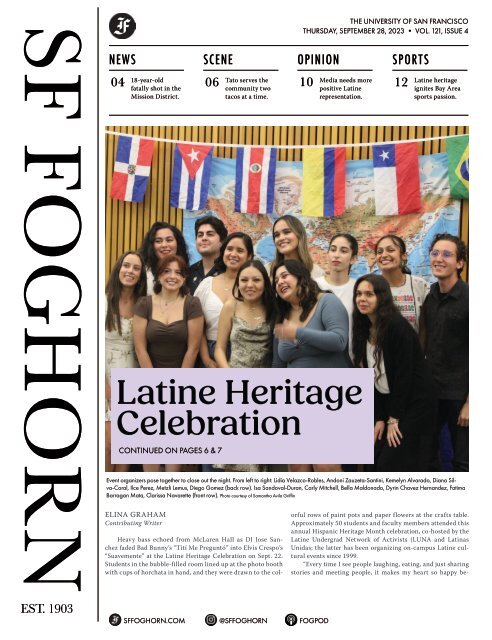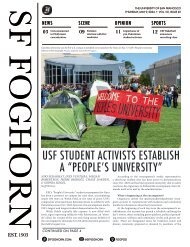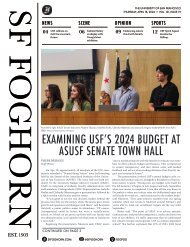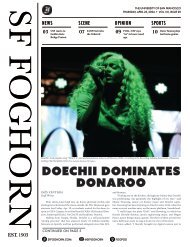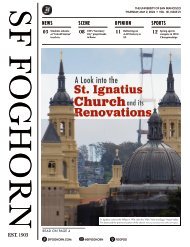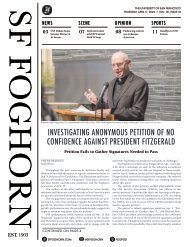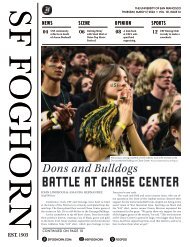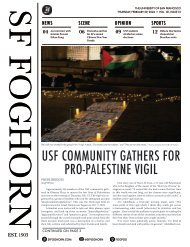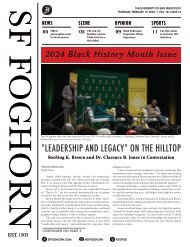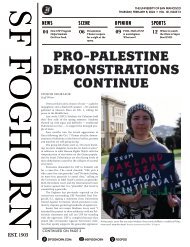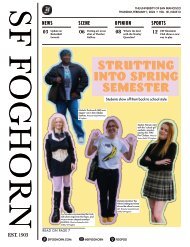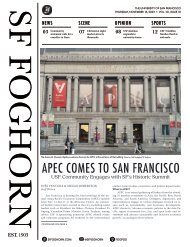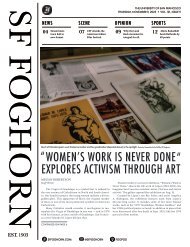You also want an ePaper? Increase the reach of your titles
YUMPU automatically turns print PDFs into web optimized ePapers that Google loves.
SF <strong>FOGHORN</strong><br />
NEWS<br />
04<br />
18-year-old<br />
fatally shot in the<br />
Mission District.<br />
SCENE<br />
06<br />
Tato serves the<br />
community two<br />
tacos at a time.<br />
THE UNIVERSITY OF SAN FRANCISCO<br />
THURSDAY, SEPTEMBER 28, 2023 • VOL. 121, <strong>ISSUE</strong> 4<br />
OPINION<br />
10<br />
Media needs more<br />
positive Latine<br />
representation.<br />
Latine Heritage<br />
Celebration<br />
CONTINUED ON PAGES 6 & 7<br />
SPORTS<br />
12<br />
Latine heritage<br />
ignites Bay Area<br />
sports passion.<br />
Event organizers pose together to close out the night. From left to right: Lidia Velazco-Robles, Andoni Zauzeta-Santini, Kemelyn Alvarado, Diana Silva-Coral,<br />
Ilce Perez, Metzli Lemus, Diego Gomez (back row). Isa Sandoval-Duran, Carly Mitchell, Bella Maldonado, Dyrin Chavez Hernandez, Fatima<br />
Barragan Mata, Clarissa Navarette (front row). Photo courtesy of Samantha Avila Griffin<br />
ELINA GRAHAM<br />
Contributing Writer<br />
Heavy bass echoed from McLaren Hall as DJ Jose Sanchez<br />
faded Bad Bunny’s “Tití Me Preguntó” into Elvis Crespo’s<br />
“Suavemente” at the Latine Heritage Celebration on Sept. 22.<br />
Students in the bubble-filled room lined up at the photo booth<br />
with cups of horchata in hand, and they were drawn to the colorful<br />
rows of paint pots and paper flowers at the crafts table.<br />
Approximately 50 students and faculty members attended this<br />
annual Hispanic Heritage Month celebration, co-hosted by the<br />
Latine Undergrad Network of Activists (LUNA and Latinas<br />
Unidas; the latter has been organizing on-campus Latine cultural<br />
events since 1999.<br />
“Every time I see people laughing, eating, and just sharing<br />
stories and meeting people, it makes my heart so happy be-<br />
EST. 1903<br />
SF<strong>FOGHORN</strong>.COM<br />
@SF<strong>FOGHORN</strong><br />
FOGPOD
02 03<br />
THURSDAY<br />
SEPT 28.<br />
2023<br />
STAFF<br />
Editor in Chief<br />
MEGAN ROBERTSON<br />
mrrobertson2@dons.usfca.edu<br />
News Editor<br />
NIKI SEDAGHAT<br />
nisedaghat@dons.usfca.edu<br />
Opinion Editor<br />
CHISOM OKORAFOR<br />
cokorafor@dons.usfca.edu<br />
Scene Editor<br />
JORDAN PREMMER<br />
jepremmer@dons.usfca.edu<br />
Sports Editor<br />
CHASE DARDEN<br />
cbdarden@dons.usfca.edu<br />
Photography Editor<br />
LEILA TSELNER<br />
latselner@dons.usfca.edu<br />
General Reporter<br />
INÉS VENTURA<br />
ipventura@dons.usfca.edu<br />
General Reporter<br />
JORDAN TYLER MARALIT<br />
jcmaralit@dons.usfca.edu<br />
415.422.5444<br />
sffoghorn.com<br />
SUBMISSION POLICY<br />
The San Francisco Foghorn is the<br />
official student newspaper of the<br />
University of San Francisco and<br />
is sponsored by the Associated<br />
Students of the University of San<br />
Francisco (ASUSF).<br />
The thoughts and opinions<br />
expressed herein are those of the<br />
individual writers and do not<br />
necessarily reflect those of the<br />
Foghorn staff, the administration,<br />
the faculty, staff or the students of<br />
the University of San Francisco.<br />
Contents of each issue are the sole<br />
responsibilities of the editors.<br />
An All-American<br />
Publication<br />
ad maiorem dei<br />
gloriam<br />
The San Francisco Foghorn is free<br />
of charge.<br />
Advertising matter printed herein<br />
is solely for informational purposes.<br />
Such printing is not to be construed<br />
as written or implied sponsorship<br />
or endorsement of such commercial<br />
enterprises or ventures by the San<br />
Francisco Foghorn.<br />
©MMIV-MMV, San Francisco<br />
Foghorn. All rights reserved. No<br />
material printed herein may be reproduced<br />
without prior permission<br />
of the Editor in Chief.<br />
SAN FRANCISCO<br />
<strong>FOGHORN</strong><br />
Freedom and Fairness<br />
Managing Editor<br />
JORDAN DELFIUGO<br />
jgdelfiugo@dons.usfca.edu<br />
Copy Editor<br />
OLIVER RIVER SATALICH<br />
omriversatalich@dons.usfca.edu<br />
Layout Editor<br />
AVA LORD<br />
ajlord@dons.usfca.edu<br />
Layout Editor<br />
ANYA JORDAN<br />
arjordan@dons.usfca.edu<br />
Social Media Manager<br />
MARIA ZAIED<br />
mfzaied@dons.usfca.edu<br />
Online Editor<br />
ESHA DUPUGUNTLA<br />
ekdupuguntla@dons.usfca.edu<br />
ADVISOR<br />
TERESA MOORE<br />
2130 FULTON STREET, UC #417<br />
SAN FRANCISCO, CA 94117<br />
Columns for the Opinion section<br />
and Letters to the Editor are gladly<br />
accepted from students, faculty, staff<br />
and alumni.<br />
All materials must be signed and<br />
include your printed name, university<br />
status (class standing or title),<br />
address, and telephone number for<br />
verification. Anonymous submissions<br />
are not published.<br />
We reserve the right to edit materials<br />
submitted. All submissions<br />
become the property of the San<br />
Francisco Foghorn.<br />
Staff editorials are written by the<br />
Foghorn editorial staff and represent<br />
a group consensus.<br />
The San Francisco Foghorn Opinion<br />
page is a forum for the free, fair and<br />
civil exchange of ideas. Contributors’<br />
opinions are not meant to<br />
reflect the views of the Foghorn staff<br />
or the University of San Francisco.<br />
Students interested in contributing<br />
to the Foghorn can scan and fill out<br />
the QR code below.<br />
STAFF EDITORIAL<br />
HONORING LATINE CULTURE<br />
THROUGH ADVOCACY<br />
The University of San Francisco is<br />
tied for first with Andrews University<br />
in campus ethnic diversity, according<br />
to the U.S. News & World Report 2024.<br />
USF can and should connect its students<br />
to progress-focused organizations and<br />
programs they may not have known<br />
about otherwise. It is imperative<br />
that USF’s partnerships are diverse<br />
in purpose so students can interact<br />
with all facets of their communities,<br />
especially as a celebration of their<br />
heritage and culture.<br />
According to College Factual,<br />
25.1% of USF’s full-time undergraduate<br />
population is Hispanic. University<br />
involvement with Bay Area Latine<br />
community organizations allows<br />
these students to develop leadership<br />
and service skills through community<br />
engagement. The hurdles Latine people<br />
face are as diverse as the community is,<br />
which is reflected by USF’s community<br />
partners.<br />
One such organization is Ayudando<br />
Latinos A Soñar (ALAS), a nonprofit<br />
working toward “social wellness<br />
through multicultural practices,<br />
mental health care, individualized<br />
and collective support related to<br />
education, immigration processes, and<br />
work,” according to their website. The<br />
organization advocates for and provides<br />
food and water to Half Moon Bay’s<br />
predominantly Latine farmworkers.<br />
USF’s involvement with ALAS<br />
started in the summer of 2020 when<br />
USF Program Coordinator for Catholic<br />
Educational Leadership Jane Bladesdale,<br />
along with her doctoral student<br />
Mauricio Diaz De Leon, helped tutor<br />
Latine children to literacy gaps fueled<br />
by pandemic-related school closures.<br />
The University Ministry supports<br />
farmworker families in Half Moon Bay<br />
with weekly tutoring sessions.<br />
At the School of Law’s<br />
Immigration & Deportation Defense<br />
Clinic, law students work closely with<br />
unaccompanied minors and families<br />
to guide them through removal<br />
proceedings, asylum hearings, and<br />
interviews. According to the School of<br />
Law website, “The majority of clients<br />
are seeking asylum and come from the<br />
Northern Triangle in Central America<br />
and Mexico.”<br />
At the School of Law’s Immigration<br />
Policy Clinic, students learn about<br />
and assist with immigration policy<br />
changes. Through the clinic, students<br />
educate people about their rights,<br />
advise lawmakers in creating effective<br />
immigration legislation, and partner<br />
with the Catholic Legal Immigration<br />
Network to assist detainees appealing<br />
to the Board of Immigration Appeals.<br />
For students outside the School<br />
of Law, there are still opportunities to<br />
get involved with the work these clinics<br />
do. According to USF’s Solidarity<br />
in Action website, the Immigration<br />
and Deportation Defense Clinic has<br />
opportunities for Spanish-speaking<br />
students to “help with interpreting<br />
during asylum interviews, interpreting<br />
during psychological evaluations<br />
and translating Spanish documents,”<br />
among other things.<br />
The Leo T. McCarthy Center for<br />
Public Service and the Common Good<br />
is another hub of student activism<br />
at USF, hosting many programs in<br />
which students interact directly with<br />
policymakers and potential voters.<br />
It’s hard to effectively incorporate<br />
activism into a busy schedule, but<br />
all students should be able to find<br />
opportunities that reflect their unique<br />
ways of activism. It is essential that<br />
USF continues to offer diverse avenues<br />
toward community engagement, so<br />
that during Hispanic Heritage Month<br />
and beyond, students can honor their<br />
culture through advocacy.<br />
ALAS hosts cultural events for the Half Moon Bay Latine community. Photo courtesy of the Half Moon<br />
Bay Review.<br />
FREE HEALTHCARE IN THE MISSION<br />
KYLA MENCONI<br />
Staff Writer<br />
An estimated three million Californians are at risk of losing<br />
their health insurance as residents will have their Medi-Cal eligibility<br />
reconsidered in the coming months, according to ABC7. As of June,<br />
approximately 225,000 Medi-Cal recipients have already lost their<br />
coverage after reconsideration, according to the California Department<br />
of Health Care Services (DHCS). The advocacy group Latino Coalition<br />
for a Healthy California found that of those who have been disenrolled<br />
from Medi-Cal during the reconsideration process, 53% identify as<br />
Latine, the most of any other racial or ethnic population.<br />
According to California Health and Human Services, Medi-Cal<br />
reviews member eligibility once a year to see whether the applicant’s<br />
property and assets exceed the eligibility limit, which was paused<br />
during the COVID-19 public health emergency. On May 11, the process<br />
resumed. On Aug. 16, CBS reported that 150,000 people across the Bay<br />
Area will have their Medi-Cal eligibility reconsidered.<br />
Latine sophomore nursing major Alejandro Marquez is one<br />
of these Medi-Cal recipients. He said, “I got something in the mail<br />
yesterday that it’s going to be reconsidered… [Medi-Cal] helps people<br />
access healthcare.”<br />
Clinica Martín-Baró, a free healthcare clinic in the Mission<br />
District, is an alternative resource that those who have lost their<br />
insurance can use. The clinic’s mission is “to promote wellness and<br />
address the health care needs of the underserved and economically<br />
disadvantaged Spanish-speaking<br />
community of the Mission District,”<br />
according to their website. All of the<br />
clinic’s services, including primary<br />
care, specialist referrals, and<br />
medication, are free.<br />
The clinic’s multiple<br />
partnerships, including San<br />
Francisco State University’s (SFSU)<br />
department of Latina/Latino<br />
Studies and members of University<br />
of California, San Francisco Health<br />
(UCSF), fund its efforts.<br />
UCSF and SFSU students run<br />
the clinic. SFSU alumni Dr. Caro<br />
Monico and Dr. Zoel Quinonez<br />
opened the clinic in 2007 during<br />
their time at UCSF.<br />
Latine sophomore nursing<br />
major Dyrin Chavez Hernandez said,<br />
“I have heard of Clinica Martín-<br />
Baró here in SF. I love the work<br />
that they are doing for our Latine<br />
community in the Mission, and<br />
I hope to be able to volunteer for<br />
them in any way I can. Start-ups like<br />
these are extremely important to our<br />
communities.”<br />
Milagros Hernandez, who has<br />
been an intern at Clinica Martín-<br />
Baró since 2018, said, “Today, a<br />
patient that I hadn’t seen in a while<br />
recognized my name and gave me<br />
the biggest hug. They always leave<br />
saying thank you so many times.”<br />
As a Latine person, Hernandez<br />
said, “When I go on a health visit,<br />
I feel unseen. I used to have to<br />
translate through my parents, so I understand the cultural barrier<br />
when people come into Clinica Martín-Baró.”<br />
Representation for Latine people is important to Marquez.<br />
“Having more and more Latino representation in the medical industry<br />
is really cool to see, because it determined that Latino people are more<br />
than capable of achieving success in the medical industry.”<br />
The clinic’s name comes from Ignacio Martín-Baró, a Jesuit priest<br />
and scholar who fought for social justice. USF has its own program<br />
dedicated to the work of Martín-Baró — the Martín-Baró Scholar<br />
program, in which first-year students work to fight food insecurity<br />
by donating food to community organizations like the Richmond<br />
Neighborhood Center and the USF Food Pantry.<br />
USF nursing students also engage with various Bay Area<br />
community organizations. These include the Academic-Practice<br />
Partnership with Kaiser Permanente, Engage San Francisco and<br />
Veteran Affairs Nursing Partnership.<br />
For Latine sophomore nursing major Sima Sadaghini, partnerships<br />
between healthcare and the Latine community are “vital and needed.”<br />
Clinica Martín-Baró is open Saturdays for free healthcare services<br />
to community members. The clinic also has a resource list with<br />
information about COVID, housing and reproductive healthcare in<br />
the broader Bay Area.<br />
Megan Robertson, Jordan DelFiugo, Oliver River Satalich and Niki<br />
Sedaghat contributed to the reporting of this story.<br />
Clinica Martín-Baró opened in 2007 to provide free healthcare in the Mission District. Photo by Kyla Menconi / SF Foghorn<br />
NEWS
04 05<br />
THURSDAY<br />
SEPT 28.<br />
2023<br />
LATINE TEEN FATALLY SHOT IN THE MISSION<br />
JORDAN MARALIT<br />
Staff Writer<br />
Damien González, an 18-year-old Latine youth, was reportedly<br />
playing basketball at the Mission Recreation Center on Aug. 18 when<br />
he was shot by a masked suspect. Police officers provided aid and<br />
called paramedics to transport him to the hospital, where he later<br />
died. No arrests have been made since the shooting took place last<br />
month.<br />
González’s family held a memorial and press conference on Aug.<br />
21 at the Mission Recreation Center to honor his life.<br />
Arturo Carillo, director of the Street Violence Intervention<br />
Program, a government program that focuses on violence and<br />
homicide prevention, described González as a “youngster well-known<br />
to the community,” as reported in the Mission Local.<br />
González’s mother, Ariana Sanchez, said to El Tecolote at his<br />
memorial, “He was about to be a dad. He was so excited. This was a<br />
stupid act, what they did to him.”<br />
A GoFundMe was created on Aug. 21 to support González’s<br />
unborn child. At the time of publication, 130 donors have raised more<br />
than $7,000.<br />
González graduated from Civic Center Secondary School and<br />
volunteered with the Latino Task Force, a civic and multilingual<br />
organization that works to inform and connect Latines in San<br />
Francisco with numerous COVID-19 resources.<br />
According to American Progress, a public policy research<br />
and advocacy organization, young Latine Americans are<br />
disproportionately at risk for gun violence victimization. In 2020,<br />
38% of Latine gun homicide victims were 24 years old or younger.<br />
Their non-Latine identifying white counterparts made up 21% of gun<br />
homicide victims in the same year.<br />
Despite only representing 4% of the population, Latine Americans<br />
aged 15 to 29 make up 8% of all gun homicide victims. An estimated<br />
65% of all gun deaths among Latine youth ages 24 and under are<br />
violent homicides, while another 30% result from suicides by firearm.<br />
District Nine Supervisor Hillary Ronen, who represents the<br />
Mission District, spoke at the memorial. She said, “We are tired of<br />
losing young people to gun violence in this neighborhood, in this<br />
country, everywhere.”<br />
According to the Washington Post, 65% of Latine adults support<br />
stronger gun control laws. In addition, 80% of registered Latine voters<br />
said gun violence would be a major factor in their vote for last year’s<br />
congressional elections.<br />
Latine politics professor Marco Durazo said, “We need stricter<br />
gun control laws at both a local and federal level.”<br />
Kemelyn Alvarado, a Latine senior politics major, said, “It is<br />
inconceivable that people cannot go about their daily lives without<br />
being concerned about themselves or a loved one becoming a victim<br />
of gun violence.”<br />
On a federal level, President Joe Biden recently announced the<br />
establishment of the first-ever White House Office of Gun Violence<br />
Prevention, which will “implement and expand upon key executive<br />
and legislative action which has been taken to save lives.”<br />
San Francisco officials are working to tighten gun restrictions.<br />
In July, the San Francisco Chronicle reported that District Two<br />
Supervisor Catherine Stefani and City Attorney David Chiu have<br />
proposed a new ordinance that would expand the ban of firearms<br />
from public spaces in San Francisco to include election facilities,<br />
hospitals, parks, places of worship, grocery stores, and restaurants.<br />
The legislative body is expected to vote on the bill later this year.<br />
LATINE MUSIC RECOMMENDATIONS<br />
Maná<br />
To celebrate Hispanic Heritage Month, the Foghorn spoke with three Latine<br />
students about their favorite Latine artists.<br />
Analicia Parish<br />
Junior Sociology Major<br />
“My favorite songs would be<br />
‘Chancla Abuser’ from the ‘Back in<br />
Brown’ album, and ‘Big Chorizo’<br />
from the ‘Grupo Sexo’ album. I love<br />
classic and hardcore punk rock music<br />
because of the political activism and<br />
goofiness of it all.”<br />
Sofia Sosa<br />
Senior International Studies Major<br />
“My mom used to listen to them<br />
a lot, and ‘Mariposa Traicionera’ is a<br />
very nostalgic song for me. She gave<br />
me this iPod Nano for Christmas<br />
one year and it had a bunch of music<br />
by them, so it’s very nostalgic to me.”<br />
Manic Hispanic<br />
NEWS<br />
González’s family held a memorial and press conference on Aug. 21 at the Mission Recreation Center to honor his life. Screenshot courtesy of @missionlocal on Instagram.<br />
Julieta Venegas<br />
Alyssa Flores<br />
Sophomore Fine Arts Major<br />
“I would recommend Julieta<br />
Venegas, she is considered a pop<br />
indie music artist. My favorite album<br />
of hers is ‘Limon Y Sal’ because I<br />
would listen to it when I was younger<br />
with my family.”<br />
Headshots courtesy of those interviewed. Screenshots of musicians courtesy of @manaoficial,<br />
@grupomanichispanic, and @julietavenegasp, (from top to bottom) on Instagram.<br />
SCENE
06 07<br />
THURSDAY<br />
SEPT 28.<br />
2023<br />
Latine Heritage Celebration<br />
CONTINUED FROM FRONT PAGE<br />
SCENE<br />
Pan dulce, or sweet bread, was brought to Latin America by the Spanish<br />
in the early 1800s. Today, it is a staple of Latine culture with lots of variations.<br />
Photo courtesy of Samantha Avila Griffin<br />
There are over 5,000 methods for preparing tamales with variations in<br />
wrapping, fillings, and cooking. Photo courtesy of Samantha Avila Griffin<br />
Aileen Robles, Emma Farfan, Nadia Gonzalez,<br />
and Lidia Velasco wore bright smiles during their<br />
first performance of the semester. Photo courtesy of<br />
Samantha Avila Griffin<br />
cause I know that’s what LUNA strives for,” said Metzli Lemus,<br />
LUNA event coordinator. “Whenever we see homesick freshmen<br />
who are here, now meeting people who share the same<br />
culture as them, like the same music as them, who look like<br />
them, it makes us all so happy to see. It’s also amazing to see<br />
people who are not Latine come in and share that culture with<br />
us — to see everyone appreciate it.”<br />
USF’s Folklórico Club provided entertainment at the celebration,<br />
performing a traditional Mexican dance to the cheers<br />
of the audience. The dancers were adorned in flowing green<br />
skirts and red flowers tucked in their hair. The club, which preserves<br />
and honors Mexican culture through dance, performs<br />
dances from regions across Mexico for various on-campus presentations,<br />
often partnering with Latinas Unidas.<br />
At the celebration, guest speakers shared stories about<br />
growing up and figuring out their Latine identities, and discovering<br />
spaces of belonging. Speaker Melissa Garcia,<br />
interdisciplinary scholar and assistant professor at<br />
USF, debuted a poem sharing her mother’s story of<br />
immigrating to California in the trunk of a car in<br />
1982. “I have never taken lightly the phrase ‘I am<br />
my ancestors’ wildest dream,’” she told the audience.<br />
As students munched on tamales and sweet<br />
conchas, speaker Mario Gonzalez, USF housing coordinator,<br />
took the stage. “When I was in college, I<br />
didn’t feel like I was Latine enough to get involved:<br />
I wasn’t listening to Spanish music enough, I wasn’t<br />
undocumented, I wasn’t a Latine studies major.<br />
The thing is, I was the only one who stopped myself<br />
from going to these events—I cut myself off from<br />
these connections and the community. People are<br />
not going to turn you away,” he said.<br />
Regarding the strength of the student organizations<br />
in promoting heritages<br />
and cultures on campus,<br />
Lemus said, “I feel like<br />
it’s the student organizations<br />
that really spearhead<br />
the events and bring to life<br />
what the students are asking<br />
for on campus.”<br />
LUNA Public Relations<br />
executive Diego Gomez<br />
said, “In what I see<br />
from campus admin, I<br />
“ The question of whether you<br />
will or won’t be accepted, it’s<br />
a risk worth<br />
taking, and I hope all of us<br />
continue to take that risk.<br />
- Christina Garcia Lopez<br />
don’t hear a lot about Latine students on campus, so we’re just<br />
trying to make the population more active through clubs.”<br />
Junior advertising student and attendee Lisa Flores said,<br />
“I think the Latine clubs on campus do a wonderful job; they<br />
provide resources, list faculty members, and host events to<br />
highlight the culture of campus. They actively work to show<br />
the community how we’re not alone.”<br />
In a closing statement that again encouraged students to<br />
take part in cultural events, Christina Garcia Lopez, director<br />
of Chicanx-Latinx studies said to the audience, “I know how<br />
difficult it can be to walk into a new space and be vulnerable,<br />
to let yourself be seen.”<br />
Lopez, also the director of critical diversity studies, continued,<br />
“The question of whether you will or won’t be accepted,<br />
it’s a risk worth taking, and I hope all of us continue to<br />
take that risk. You taking that risk makes USF a better place<br />
— your passion, empathy, you inspire us.”<br />
Both Latinas Unidas and LUNA have many future celebrations<br />
lined up, and encourage all Dons to come out and<br />
support on-campus offerings, such as Molcajete, an event that<br />
supports local vendors, on September 28th at Privett Plaza.<br />
a”<br />
Students place pins to map their cultural origins.<br />
Photo courtesy of Samantha Avila Griffin<br />
Students were served conchas, tamales, and horchata.<br />
Photo courtesy of Samantha Avila Griffin<br />
SCENE
08 09<br />
THURSDAY<br />
SEPT 28.<br />
2023<br />
TATO’S TACO LOVE FOR THE COMMUNITY<br />
CENTRAL AMERICAN SUSTAINABILITY<br />
SCENE<br />
JORDAN MARALIT<br />
Staff Writer<br />
On a sunny Saturday afternoon, I left the Hilltop in search of<br />
local Mexican food. In an attempt to immerse myself in different<br />
neighborhoods, I visited Tato in the Bayview district.<br />
When I walked in, I was greeted with a sign reading “Hecho<br />
En Bayview” which means, “Made in Bayview.” The interior of the<br />
restaurant looked like a mixture of a modern aesthetic but with<br />
decorations of what you would see in a traditional Mexican restaurant.<br />
The restaurant had a hexagon-shaped floor, seat booths attached<br />
to the wall, and lighting on top of the ceiling. It also has a<br />
bar where customers can sip their margaritas. The restaurant also<br />
has an outdoor patio for customers. To settle in, I ordered a carne<br />
asada burrito.<br />
Tato is perhaps best known for its Friday “Taco Love” special,<br />
which includes two tacos with sides and pay-what-you-can pricing.<br />
Customers can choose among beef, chicken, and mushroom tacos<br />
for the deal. The full meal comes with two tacos and sides like rice,<br />
beans, or salad.<br />
With many people in the city still recovering from the hardships<br />
faced by the COVID-19 pandemic,<br />
Every Friday from 11 a.m. to 4 p.m., customers can order off the<br />
Taco Love menu and pay anywhere from zero to $10. When a customer<br />
pays the full price of $10, Tato will “feed someone in [their]<br />
honor,”<br />
accord i ng<br />
to the restaurant’s Instagram. Tato is partnered with the non-profit<br />
organization SF New Deal. SF New Deal launched in March 2020<br />
as a rapid response to COVID-19. They utilize private donations<br />
and government-funded service contracts to help pay local restaurants<br />
to provide meals for their neighbors in need.<br />
SF New Deal partners with local restaurants to create meals for<br />
neighbors in need and providing income for workers and bringing<br />
food to the community. Within 6 months of its launch, the SF New<br />
Deal delivered over 800,000 meals, and local restaurants have received<br />
over $8,000,000 in direct financial relief.<br />
Tato’s owner and Bayview resident, Kristin Houk is a beneficiary<br />
of the SF New Deal program. According to the San Francisco<br />
Chronicle, Houk’s nonprofit background led to her interest in both<br />
feeding people and recovering food waste. Houk gave away more<br />
than 25,000 free meals last year as part of the SF New Deal community<br />
program that pays restaurants to feed low-income residents,<br />
according to CBS News. She also owns All Good Pizza and Cafe<br />
Almá, and officially observed that the Bayview is under “There are<br />
a lot of people out there at this moment who can benefit from getting<br />
a meal, whether you pay $10 or 10 cents” she said to the Chronicle<br />
in 2020.<br />
She continued, “Food is such a tremendous cost to families so<br />
if we can use some of that extra food that’s out there and get it to<br />
people in dignified ways, it’s an important thing to work toward.”<br />
Houk named the restaurant after her son, signifying that Tato<br />
is about family, community, and the tradition of bringing people<br />
together through good food, times, and conversation.The restaurant<br />
was established in 2017 to pay homage to Houk’s<br />
family from Michoacan and Mexico City, Mexico.<br />
I visited the restaurant on a Saturday, and<br />
employees were busy packaging meals to be<br />
donated, based on Friday’s pay-what-youcan<br />
profit. The workers packaged the<br />
meals using reusable meal prep, tupperware,<br />
containers to further aid<br />
the person receiving the meal.<br />
Amer Diaz, Tato’s head<br />
chef, said,“The idea of Taco<br />
Love started around the<br />
pandemic time. We saw<br />
that people were struggling<br />
and we wanted to<br />
make a difference.” Diaz<br />
has worked for Tato since<br />
2018.<br />
After enjoying my<br />
burrito, I bought two<br />
steak tacos to-go for dinner<br />
later that night in my<br />
dorm.<br />
Diaz encouraged all<br />
forms of the community<br />
through college students<br />
to the local residents,<br />
“Come out and Support! It’s<br />
nice to help people.”<br />
Tato plans to offer Taco<br />
Love “indefinitely every Friday.”<br />
Tato’s carne asada burrito. Photo by Jordan Maralit / SF Foghorn<br />
LUIS PÁRRAGA is a junior<br />
international studies major.<br />
El Salvador’s Ministry of<br />
Environment and Natural Resources<br />
announced the discovery of a new<br />
tree species in the country, identified<br />
as Sapranthus pinedai. “This natural<br />
jewel was discovered in one of our<br />
Protected Natural Areas and adds<br />
a unique touch to our biodiversity,”<br />
the authorities reported in Spanish<br />
on X, formerly known as Twitter, on<br />
Sept. 12.<br />
The identification of this new<br />
species serves as a reminder of Central<br />
America’s incredibly varied range of<br />
tropical landscapes, flora and fauna.<br />
The region accounts for “8% of the<br />
world’s biological diversity, allocated<br />
in 206 ecosystems, 33 ecoregions,<br />
and 20 life zones,” according to the<br />
Central American Commission for Environment and Development.<br />
Central America’s environmental contributions are important for the<br />
global discussion around the transition towards a green economy, as<br />
its current efforts to deal with the impact of climate change meet its<br />
biodiversity and ancient history of sustainable practices and beliefs.<br />
As someone from El Salvador, I think of Central America<br />
as a “phoenix” region. Environmental shocks and setbacks are a<br />
consistent threat to the region’s wellbeing. 2020 proved to be one<br />
of the most difficult years in recent memory, as the sanitary and<br />
economic consequences of COVID-19 converged with two destructive<br />
hurricanes, Eta and Iota, in November. However, the other constant is<br />
the region’s ability to bounce back from the ashes. A joint report by the<br />
Official Monetary and Financial Institutions Forum and the Central<br />
American Bank for Economic Integration released in December 2021<br />
predicted a faster post-pandemic recovery for Central America than<br />
for the rest of Latin America and the Caribbean, associating this<br />
to growing sustainably-focused investments.<br />
Climate hazards are increasingly understood to have a<br />
possible “multiplier” effect on other concerns in Central America,<br />
as they interact with pre-existing socio-political conditions. The<br />
consequences of this include increased migration and insecurity<br />
rates, as observable immediately after the aforementioned 2020<br />
storms. Despite their high vulnerability, most countries in the area<br />
ranked poorly in their level of readiness, according to the Notre<br />
Dame Global Adaptation Initiative’s climate change vulnerability<br />
index. Readiness is understood as “a country’s ability to leverage<br />
investments and convert them to adaptation actions.” Countries<br />
like Nicaragua and Honduras are found within the bottom twentyfive<br />
of this world ranking.<br />
One of the efforts being put forward to improve Central<br />
America’s climate preparedness is the implementation of naturebased<br />
solutions. Nature-based solutions are actions aimed towards<br />
protecting natural resources and environments, while also<br />
tackling various social issues, such as food insecurity and climate<br />
change-related disasters. When it comes to storm management,<br />
implementing these solutions means avoiding the negative impacts<br />
of man-made infrastructures, while simultaneously addressing<br />
the needs of the communities surrounding these projects. For<br />
instance, Swiss Info reported in June on the construction of<br />
“chinampas” in the Jiquilisco Bay area of El Salvador. These small,<br />
floating islands made from bamboo serve as platforms to grow<br />
mangrove trees, which will act as a natural barrier from floodings,<br />
and simultaneously serve as the breeding grounds for several fish<br />
species that aid in the subsistence of local fishermen.<br />
Central America’s indigenous past could also guide<br />
humanity’s approach to handling natural resources today. As<br />
per Encyclopedia Britannica, the Maya civilization occupied most of<br />
Central America, inhabiting the land from modern Southern Mexico<br />
to what is now Nicaragua. According to anthropologist Lisa Lucero,<br />
the Maya managed to maintain a sustainable relationship with the<br />
environment because they held a “cosmology of conservation,” where<br />
all equal things on Earth share equal responsibility in maintaining the<br />
planet.<br />
The ancient city of Tikal, located in present-day Guatemala,<br />
was home to at least 60,000 Maya at its peak, around 750 A.D. The<br />
residents took advantage of the eight-month rainy season to meet their<br />
water needs. They build paved reservoirs to hold rainwater to be used<br />
during the dry months, as published in Proceedings of the National<br />
Academy of Sciences. As stated by researcher Vernon Scarborough:<br />
“These people were able to use their land and water resources in a<br />
sustainable manner for as long as 1,500 years without significant<br />
interruption… In developing nations where water and energy are<br />
scarce, simple solutions may work better than new, costly technologies<br />
that are prone to break.”<br />
The limitations that characterize the daily life experiences<br />
of Central Americans are also a reminder for citizens of developed<br />
nations to take care of the resources they do have at hand. Growing<br />
up in a country like El Salvador, where essential services like water<br />
supply are often interrupted and inaccessible to a significant number<br />
of citizens, it became evident that resourcefulness becomes a survival<br />
tool. Many families, including my own, have had to invest in domestic<br />
water storage tanks to be able to meet this basic need whenever issues<br />
relating to this service are not efficiently dealt with. We’ve also used<br />
alternatives like rainwater harvesting and purification. In any case,<br />
the available supplies are limited, and a wise usage is required. This<br />
same rationale needs to be applied where access is more widespread if<br />
we want natural resources to continue to be available in the upcoming<br />
decades, and we can turn to age-old and green solutions to make this<br />
management as effective as possible. We can all learn lessons from<br />
Central America for sustainable living and development.<br />
Graphic by Sophie Reichert, Graphics Center<br />
OPINION
10 11<br />
THURSDAY<br />
SEPT 28.<br />
2023<br />
¡YA BASTA!: WE NEED MORE LATINES IN MEDIA<br />
INÉS VENTURA is a sophomore<br />
media studies major.<br />
“Basta,” my favorite word in<br />
Spanish, perfectly encapsulates a<br />
very frustrated and fiery “enough.” It<br />
is a word best used when “enough”<br />
just isn’t enough to translate how<br />
badly you’ve reached your wits’ end.<br />
As a Latine woman, that’s exactly<br />
how I feel about the continued lack<br />
of appropriate Latine representation<br />
in mainstream film and television.<br />
Ethnic representation<br />
has received more attention in<br />
recent years than ever before. Our<br />
118th congress is the most racially<br />
and ethnically diverse ever, spring<br />
2022 had the most diverse models<br />
in fashion history, and as of 2021,<br />
people of color held 47% of entrylevel<br />
positions within the federal<br />
labor workforce. We’re seeing real action taking place to correct the<br />
ways in which underrepresented groups have previously been denied<br />
opportunities to hold space.<br />
This has been seen within the media sphere of film and<br />
television. According to UCLA’s annual Hollywood Diversity report,<br />
people of color accounted for one third of lead roles in 2022’s top<br />
streaming films. Although more representation is happening across<br />
the media industry, there’s still a lack of it for Latine people. Despite<br />
the Latines accounting for 19% of the U.S. population, making us the<br />
largest ethnic minority in the country, representation in the media<br />
industry workforce increased by only 1% in the last decade, from 11%<br />
to 12%, according to the U.S. Government Accountability Office.<br />
Media portrayals need to keep up with the momentum at which we’re<br />
moving. The lack of growth within our sector of the media has left<br />
little opportunity to create new content that accurately reflects what<br />
it means to be Latine.<br />
There is a huge disconnect present between what is perceived as<br />
Latine heritage, and what it actually stands for. This is most apparent<br />
in the films and shows that resurface with every Hispanic Heritage<br />
Month. Every year, streaming services suggest a collection of Latinecentered<br />
content, but these titles still center outdated narratives<br />
and character representations that continue to reinforce harmful<br />
stereotypes and misconceptions. “Miss Bala” follows Gina Rodiguez’s<br />
character Gloria Fuentes being thrown into a drug ring after spending<br />
just one night in Tijuana. To add insult to injury, she falls in love with<br />
the main drug lord, who continuously puts her life in danger. The cult<br />
classic “Scarface” shows Al Pacino, who is not Latine, playing a Cuban<br />
immigrant who meets his demise after taking over a drug cartel in<br />
1980’s Miami. Even if a film or show has Latine characters, they are<br />
often portrayed in drug-affiliated drama, as female characters who play<br />
into the “spicy Latina” trope, or as Latine youth struggling with gangrelated<br />
violence. Netflix’s “On My Block” shows a group of East LA<br />
teenagers grappling with gang violence on top of the socio-economic<br />
struggles they face in their predominantly Latine community.<br />
In the cases where a Latine success story is appropriately<br />
highlighted, it’s often a story that’s been recycled so much that it<br />
becomes oversaturated with how often it is used as an example for<br />
positive representation — news flash: there are more Mexican artists<br />
than Frida Kahlo. Latine heritage continues into the present, so why<br />
are we sticking to the same old stories?<br />
This is due in part to the fact that Hispanics and Latines account<br />
for only 4% of media management positions and 12% of the overall<br />
media workforce, as found in a 2021 study by the the Government<br />
Accountability Office. The small number of Latine media contributors<br />
is even more concerning when compared to the high amount of<br />
consumers Latines account for. The Alliance for Inclusive and<br />
Multicultural Marketing found that two-thirds of Hispanic households<br />
watch TV and movies online, with 70% of those households subscribed<br />
to Netflix and other popular streaming services. This gap is where<br />
Latines are becoming invisible. Representation matters, not only<br />
because it affects how other people see us, but how we see ourselves<br />
too. We need stories that reflect how we’re succeeding despite the<br />
struggles that are played out in the films and shows that are supposed<br />
to represent us.<br />
According to a 2022 report from the Latino Donor Collaborative,<br />
which highlights the ways in which Latines are thriving, the U.S.<br />
Latine gross domestic product was $2.8 trillion in 2020. If Latines<br />
were a standalone economy, it would be the 5th largest in the world.<br />
Latine high school graduation rates increased from 69% to 90% over a<br />
10 year span, and there has been a 37% increase in how many graduates<br />
enroll in post-secondary institutions. There is so much success within<br />
the Latine community to celebrate, and there will continue to be.<br />
It’s time to swap stereotypical narratives for Latine success<br />
stories. With this year’s Hollywood strike putting the industry’s future<br />
in question, we need to make sure that Latine writers and actors are<br />
part of whatever solution will bring about the fairness and equity we’ve<br />
been waiting for.<br />
As a growing generation of media consumers and contributors, we<br />
hold a special power that decides what types of stories we want told in<br />
the future. We should all be calling “basta” on what’s going on in the<br />
media so that we can create space for positive narratives that inspire<br />
and promote visibility for Latines.<br />
OPINION<br />
“Scarface” (1983), starring Al Pachino as Tony Montana, was criticized by the<br />
Miami City Commissioner at the time for a negative portrayal of Cuban refugees.<br />
Screenshot courtesy of @mafia.movie.empire on Instagram.<br />
Gloria Fuentes (Gina Rodriguez) gets entangled in Lino Esparza’s (Ismael Cruz<br />
Cordova) gang in the controversial movie “Miss Bala” (2019). Screenshot courtesy of<br />
@missbalamovie on Instagram.<br />
Mexican painter Frida Kahlo’s self-portraits earned her international<br />
renown for their bold colors and moving expressionism. Screenshot<br />
courtesy of @filmdeprived on Instagram.<br />
Oscar Diaz (Julio Macias) confronts Ruby Martinez (Jason Genao)<br />
in season 2, episode 2 of “On My Block.” Screenshot courtesy of<br />
@onmyblocknetflix on Instagram.<br />
OPINION
12<br />
THURSDAY<br />
SEPT 28.<br />
2023<br />
BAY AREA SPORTS EMBRACE LATINE HERITAGE<br />
Pro sports franchises have begun to recognize the heritage and culture of their Latine fanbases. Photo courtesy of Hayley Hom/49ers<br />
SPORTS<br />
CHASE DARDEN<br />
Staff Writer<br />
As professional sports franchises begin to celebrate Hispanic<br />
Heritage Month, teams in the Bay Area have made an effort to<br />
acknowledge such a large part of their fan bases.<br />
The Latine community makes up 39% of California’s population.<br />
It is the largest ethnic group in the state, and the third largest in the<br />
Bay Area, at 24%, according to SFist.<br />
The Latine community’s impact is seen in the sports world,<br />
specifically regarding Bay Area fandom. The Bay Area has six<br />
professional sports teams from San Jose, Oakland, and San Francisco<br />
– the San Francisco Giants, San Francisco 49ers, and Golden State<br />
Warriors among others.<br />
In May, Vivid Seats, a leading ticket sales company, collected data<br />
from their National Football League (NFL) ticket sales and found that<br />
the 49ers are not only the most popular NFL team in the Bay Area, but<br />
also in the state of California. Out of California’s 58 counties, 45 root<br />
for the 49ers.<br />
In the National Basketball Association (NBA), the Warriors are<br />
one of the most dominant franchises in the last decade. The Warriors<br />
made waves after the 2022 championship when Warrior and Oakland<br />
native Juan Toscano-Anderson became the first player of Mexican<br />
descent to win an NBA championship, according to NBC.<br />
25-year-old Ysenia Rubio, a Latine San Francisco native from the<br />
Excelsior District, said, “We are already passionate about our roots<br />
and heritage. We bring that passion to our home sports teams as well<br />
— I have seen the passion in and out of our home stadiums. My favorite<br />
way to celebrate after a big win is going to the Mission and watching<br />
my community have our own parade with low riders, fireworks, and<br />
loud music.”<br />
Pro sports teams recognize their Latine fan bases through special<br />
events during Hispanic Heritage Month and throughout the year.<br />
“All of our home teams have begun to acknowledge Hispanic<br />
Heritage Month, such as ‘Fiesta Gigantes’ at Oracle Park,” said Rubio.<br />
“These events show that the teams recognize us, and give us the same<br />
love we give them.”<br />
The annual ‘Fiesta Gigantes’ has been a tradition since 2005,<br />
where players celebrate the impact Latines have made on the game<br />
of baseball and the city of San Francisco. Giants also had a Mexican<br />
Heritage Night on Sept. 12, which they hold annually at Oracle Park.<br />
Last week, the 49ers held their annual Hispanic Heritage<br />
Night game in which they recognized the “histories, cultures, and<br />
contributions of American citizens whose ancestors came from Spain,<br />
Mexico, the Caribbean, and Central and South America, through<br />
unique activations, events, and merchandise,” according to their<br />
website.<br />
49ers game activations are intended to be engaging additions to<br />
the lineup of in-game entertainment. The 49ers began their Hispanic<br />
Heritage Night game with the traditional sounding of the foghorn, led<br />
by offensive lineman Alfredo Gutierrez, an international player from<br />
Tijuana, Mexico.<br />
The 49ers’ Chief Marketing Officer Alex Chang stated, “Our<br />
Latino Heritage Month activations celebrate the unique culture and<br />
people that are a part of the fabric of the 49er Faithful and of the<br />
Bay Area. Latino pride runs deep within our organization, from our<br />
players, to our fan base, to our staff.<br />
“In fact, our Latino employee resource group, LEAD [LatinX,<br />
Empowerment, Advancement, and Development], plays a key role in<br />
developing our Latino Heritage Month plan,” he said.<br />
Emmanuel Zamora Corral, a 21-year-old San Francisco native<br />
from the Mission District, said, “My dad influenced me and taught me<br />
how to love Bay Area sports.“My father is an immigrant from Mexico,<br />
and since then, he’s always been a 49ers fan and has shown my brother<br />
and I his love for the Niners and all teams in the Bay. It’s a family thing<br />
with sports.”<br />
Rubio also shares a love of sports. “My biggest influence on my<br />
love of Bay Area sports is my grandfather. He came to the Bay from El<br />
Salvador in his late teens,” Rubio said. “At that time, American sports<br />
leagues were nothing like they were today. However, his love for San<br />
Francisco teams has not changed since then.”<br />
“He’s always enjoyed the 49ers and Giants and has loved seeing<br />
the Warriors transform over the years. He’s been lucky enough to see<br />
memorable moments for teams at Kezar Stadium, Candlestick Park,<br />
and Oracle Park — before it was even known as Oracle Park,” Rubio<br />
said. “Although he’s gotten older and doesn’t enjoy crowds as much,<br />
one thing he makes sure to do is watch his teams play from the comfort<br />
of his home. I love watching and talking with him about the games.”<br />
Corral said, “Sports culture has contributed a lot to the Hispanic<br />
community because our community has a very strong family mentality,<br />
in that we all care for one another at home, as well as on the field or<br />
on the court,”<br />
He continued, “I think sports in the Hispanic community can<br />
evolve through representation, in sports that aren’t necessarily<br />
dominated by Hispanics. For example, the more Hispanics that get<br />
into football, the more children will see that and try the sport out for<br />
themselves, and that goes for various sports, not just football.”<br />
On Sept. 30, the Giants will host their “Fiesta Gigantes” game<br />
against the Los Angeles Dodgers. The players will wear their “Gigantes”<br />
jerseys and there will be live music from Spanish-language rock bands<br />
as well as special food offerings.


